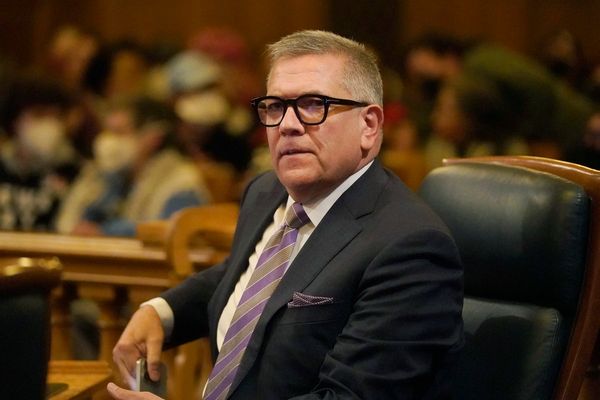
Can you make everything better with a bus? “I can’t speak for everyone,” says Janet McGlone, 74, onboard the SL3 Superloop service from Thamesmead shopping centre on her way home to Bexleyheath in south-east London. “But this has been a godsend for us.”
The Superloop, a psychedelic-branded network of express orbital buses dreamed up by the London mayor, Sadiq Khan, at the height of opposition to Ulez, has been running for just over a year, attempting to provide better public transport in the capital’s outer boroughs.
McGlone’s trip to the shops now takes 14 minutes, rather than 35 minutes on the 401 bus she previously used. “It’s so much easier – otherwise it was just stop after stop.” The growth in passenger numbers in the corridors where Superloops operate is likewise whizzing past the rest of the bus network, at 11% annually compared with 2%, Transport for London (TfL) says.
In Greater Manchester, the Bee Network, the work of Khan’s fellow Labour mayor Andy Burnham, is also approaching its anniversary milestone. The first swathe of franchised bus routes, which started running out to Bolton and Wigan last September, have seen a leap in patronage too, up 5% in six months, with significantly more services running to schedule.
For a Labour government that has pledged to improve public services and grow the economy, but also declares itself trammelled by the state of public finances, buses are an appealing solution. Even without the spectre of a half-built, £50bn-plus HS2, a bus network would always be substantially quicker and cheaper to deliver than a new railway.
But the bus successes of two of the UK’s biggest cities are the exception, not the rule. Outside the capital, since deregulation under Margaret Thatcher’s government in the 1980s, bus services have been in decline: there were 2bn fewer journeys in 2023 than in 1985, according to Department for Transport statistics, and 6,000 fewer buses on the road since Labour was last in power in 2010.
London was exempted from deregulation and Manchester was the first to reverse the process, under powers granted to metro mayors. The government will now extend those franchising powers to every local community, as well as lowering the hurdles that Burnham had to overcome.
“Buses are the lifeblood of our communities, but for too long people have suffered because of unreliable services,” says the minister for local transport, Simon Lightwood. The better buses bill announced in the king’s speech will, he says, “empower local authorities to take back control of their bus services, while our plans to reform bus funding will give local leaders greater power and flexibility to deliver local transport priorities”.
But will devolving power be enough? Khan has said passenger figures show that “if you build it, people will come and use it”. But, as the LSE local government professor Tony Travers cautions, suburban or orbital buses are no surefire winner: “Having them in any city would appear a good thing; whether they are economically viable I’m not sure. The further you get out, the fewer people there are wanting to use them.”
While funding has been found for the Superloop, there have been uncomfortable reminders that the economics of suburban routes remain fraught. Sullivans, a small business that had long operated buses for TfL, this month quit its north London franchises saying it could “no longer sustain the increasing cuts necessary to meet the decreasing income”. It said the situation was worsened by financial penalties incurred for late-running buses, which it blamed on congestion.
Traffic is the grim reality check that can leave any Superloop on a doom loop. For now, the SL1, running for much of its route along the three-lane North Circular, with limited stops, easily outpaces local alternatives, according to regular passengers.
At the front of the top deck is Mike Mist, 23, who connected from the SL10 from Kingsbury in north-west London to go to his work as an engineer in Edmonton. “It’s definitely a big difference. I would have had to take two more buses,” he says. The Superloop service started a month before he got the job, and without it, he reckons, the commute “would have been too much – too long and too expensive”.
Agnes Dabrowska, 49, who runs a small cleaning company in Walthamstow, gets on at Silver Street. “It’s a huge difference, I’m much happier.” The 34 bus was always busy, passing two colleges. “Now there are only four stops. If there’s no traffic we can get there in 10 minutes, which is nothing.”
But as the SL1 bus turns off the North Circular to make the last few stops on the route, progress is less serene. At the Walthamstow Market stop, a dread combination of a dug-up lane, a parked removal van and a wide lorry have made the road in effect impassable. Another SL1 is stuck on the other side of the road.
“Congestion is a killer. In every sense,” says Giles Fearnley, a consultant who for a decade led FirstBus, running bus operations around the UK. Not only the health impact of heavy traffic on the air people breathe – the impetus for Khan’s Ulez expansion – but what it does to buses.
While better buses, in theory, can replace dozens of cars on the road, only frequent, reliable and affordable services can tempt drivers to switch: and slower speeds mean more vehicles and drivers are needed to run a regular timetable, driving up costs. Where the road space is constrained, the Superloop hits trouble. But, says Fearnley: “If you can speed up a bus journey you improve the utilisation massively and reduce the costs – that’s the magic.”
That is why, says Stephen Rhodes, the director of bus travel at Transport for Greater Manchester (TfGM), the extension of franchising plans under Labour is welcome – but that change can only be a first step. “Franchising is an enabler. It makes things easier and it gives us more levers to pull, but we still need to do a lot; whether that’s red routes, or other infrastructure improvements working with local authority partners.”
Building up a new transport network around buses may take a fraction of the time and money of constructing any kind of rail line, but it is not negligible. The Bee Network has cost TfGM about £135m to date, including £500,000 just to repaint the first 93 buses yellow. The Superloop cost TfL more than £5m to set up, with an estimated annual running cost of £34m.
Ahead of franchising, the more antagonistic private bus companies said the costs would hammer the public purse. Rhodes counters: “We never promised it was quick and easy, and certainly not free. We think franchising gives us better value in cost per bus.”
Devolution and franchising puts more focus on quality, he believes: the transport authority feels more accountability while the bus companies concentrate on performance. And it helps convince local councils to work on hotspots where a tweak to street layouts or priorities can significantly help bus services flow: “They feel more pride in the network and have more skin in the game – the benefits don’t just flow back to shareholders and public limited companies.”







